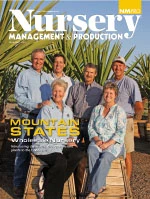The National Nursery Industry Survey is conducted every five years by the Green Industry Research Consortium of agricultural economists and horticulturists from 24 land-grant institutions in the U.S. This 2003 data is the latest information available. Results for the 2008-2009 National Nursery Survey will be available in 2010. The survey data were broken into eight geographic regions: Appalachian, Great Plains, Midwest, Mountain, Northeast, Pacific, South Central and Southeast.
The consortium examined the types of nursery rooting media systems used (containers, balled and burlap, field grown, etc.), sources of irrigation water and application methods and adoption of integrated pest management practices.
With an emphasis on water conservation, the consortium also recognized the need to document the efforts made in the green industry to improve the efficiency of water applications in the nursery and/or greenhouse.
Rooting media systems
Container-grown products were the dominant root packaging category in 35 of the 44 states in the survey with an overall weighted average of 63 percent of sales. For 31 states, it was the largest percentage category, and there were four regions for which more than half the sales were containerized plant materials (Figure 1).
Sales of balled and burlapped (B&B) plants were a distant second with an overall share of 16.3 percent and the greatest number being sold in the Midwest region (33.5 percent of sales). Bare root sales ranged from only 5 percent of sales in the Northeast to nearly 15 percent in the South Central region. Pot-in-pot production systems, though becoming increasingly popular, represented less than 2 percent of sales in all regions, ranging from 0.4 percent in the Pacific to 1.8 percent in the Great Plains region. The averages for the “Other” category were not separated because it included the combined sales of balled and potted, processed balled, field grow-bags, in-ground containers (pot-in-pot) and other unspecified product forms.
 A total of 2,485 usable questionnaires were returned, representing an overall response rate of 15.9 percent. Data from Alaska, Arizona, Alabama, Kansas, Maryland and Wisconsin were not submitted.
A total of 2,485 usable questionnaires were returned, representing an overall response rate of 15.9 percent. Data from Alaska, Arizona, Alabama, Kansas, Maryland and Wisconsin were not submitted.
Irrigation source
Availability of water supplies for nursery irrigation is an increasingly critical issue in many parts of the country. The survey inquired about sources of irrigation water and changes in water use during the past five years. The sources of irrigation water were natural surface, recaptured, city or wells.
Overall, 53 percent of all respondents used irrigation water supplied by wells, which ranged from 27 percent in the Appalachian region to nearly 72 percent in the Southeast (Figure 2). Natural surface water was the next most important source and supplied water for 24 percent overall, but ranged from 14 percent in the South Central region to 45 percent in the Appalachian region. Recaptured water was a source for less than 5 percent of respondents, except in the Appalachian region (8.6 percent). City water was most important in the Mountain (20.8 percent), Pacific (24.3 percent) and South Central (29.6 percent) regions.
Water use
The survey asked if the use of irrigation water during the past five years (on a per-acre basis) had increased, remained the same or decreased. If there was a change, respondents were asked to provide a percentage estimate. It appeared the majority of firms held water use on a per-acre basis constant, while most of the remaining share of firms increased rather than decreased water use.
Nurseries in the Southeast, Mountain and Pacific regions maintained relative constant use of water, while more of the Great Plains, Northeast, Midwest, Appalachian and South Central region nurseries indicated a slight increase in the amount of water used on a per-acre basis. The change in irrigation water used ranged from a 6.9 percent increase in the Mountain region to a 12.1 percent increase in the Appalachian, 12.8 percent in the Northeast and 15.5 percent in the South Central regions.
Overhead irrigation systems were used by the majority of nursery firms responding, ranging from 42 percent usage in the Great Plains to 78 perecent in the Southeast. Other major irrigation systems used included drip irrigation, particularly in the Pacific (44.7 percent), Mountain (46.6 percent) and Southeast (52.4 percent) regions. Subirrigation methods were seldom used except in the Great Plains (10.4 percent) and Mountain (22.7 percent) regions. Almost 21 percent of the Great Plains nurseries used irrigation systems other than those specified. Note that respondents were allowed to choose more than one type of water source or irrigation system, so percentages could sum to more than 100 percent.
Integrated pest management
Integrated pest management (IPM) has become an established approach to pest management in the nursery and greenhouse industry. The most commonly used practices, reported by at least half of respondents, were removing infested plants or plant parts (88 percent), cultivation and hand weeding (77 percent), spot treatment with pesticides instead of broadcast spraying (73 percent), inspecting incoming stock for insects/diseases (72 percent), alternating pesticides to avoid pesticide resistance (63 percent) and elevating plants for air circulation (60 percent).
Other common practices used by one-third to one-half of respondents were ventilating greenhouses (45 percent), adjusting fertilization rates to control weed/pest growth (45 percent), managing irrigation to reduce pests (39 percent) using pest-resistant varieties (38 percent), using mulches to suppress weeds (37 percent), adjusting pesticide application to protect beneficials (37 percent) and disinfecting benches or ground covers (36 percent).
Significant regional differences were seen in many of the IPM practices. In the Southeast region, where pest pressures are generally high, there were high rates of alternating pesticides to avoid chemical resistance (74 percent), elevate or space plants for air circulation (70 percent), adjusting fertilization rates (56 percent), managing irrigation to reduce pests (52 percent) and disinfest benches or ground cover (45 percent). The Pacific region had similarly high levels of some of these same practices, as well as cultivation/hand weeding (86 percent), ventilate greenhouses (60 percent), use of biopesticides or reduced toxicity pesticides (27 percent) and use of beneficial insects (27 percent).
The Great Plains and Mountain regions had high usage of mulches to suppress weeds, cultivation/hand weeding, and spot treatment with pesticides. The use of beneficial insects was also high in the Mountain (23 percent) and South Central (24 percent) regions. Practices that did not significantly vary regionally included removing infested plants or plant parts, using sanitized water foot baths, soil solarization, beneficial insect identification, adjusting pesticide application to protect beneficials and inspecting incoming stock.


This industry analysis was compiled and written by Alan W. Hodges, University of Florida, awhodges@ufl; Charles R. Hall, Texas A&M University, chall@ag.tamu.edu; Bridget K. Behe, Michigan State University, behe@anr.msu.edu; Jennifer H. Dennis, Purdue University, jhdennis@purdue.edu; and Robin G. Brumfield, Rutgers University, brumfield@aesop.rutgers.edu.
Get curated news on YOUR industry.
Enter your email to receive our newsletters.
Explore the November 2009 Issue
Check out more from this issue and find your next story to read.
Latest from Nursery Management
- Connect with us at MANTS
- GardenComm Conference tours
- Garden Center magazine announces dates for 2025 Garden Center Conference & Expo
- Veseris expands in turf and ornamental with acquisition of Tessman and Lynde companies
- The next 100 years
- Spring Survival Guide
- Protect your operations with cyber security and cyber insurance
- Q&A With James Saunders








